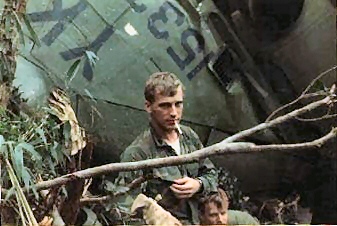The Day After The CH-46E Crash


Some of the old Marines I met at both Cherry Point and New River are working on identifying old Purple Fox aircraft still on the roster. Will update you when I get some info back.
I was at New River the morning after the crash of the CH-46E into New River. The next day I talked to the crew of the Search And Rescue (SAR) aircraft out of Cherry Point which responded to the accident.
I spent some time on the flight line of HMM-263 at New River and with the 'Pedro' SAR guys at Cherry Point. We have some fine young men out there. They kept calling me "Sir" even after I tried to explain that my parents were married. I am a cynical old fart, but it was still a very moving experience.
Do you remember the characteristic smell of the CH46? Hydraulic fluid and sweat, mostly sweat. It's still there.
The kids are taller, better looking, and smarter than we were. They are still trying to fly and fight a machine without adequate support, however. All the V-22s are being mothballed, except two that will be disassembled and trucked to Pax River for more flight testing. The entire load has been shifted back to the CH-46 fleet, which has been grossly under funded and neglected for almost 15 years. The problems with the 46 are easily identified and fixed, but there have been no funds to do this.
While they get the V-22 sorted out, these men will continue to carry the load with a machine which has been allowed to degrade. Some of them will die, and others have already died, as a result of bad decisions. You can pick your villains here, but the fact is that these are our kids, and we are putting them in harm's way.
The CH-46 was to begin phase out in 1990, with the delivery of the first Ospreys. Problems which could be 'lived with' until phase out were defunded. This included, among other things, complete rewiring of the machines, long-term structural repairs, and upgraded components required because the original components were obsolete and unsupported.
Eleven years on, most of these machines, including the E-models, have wiring harnesses older than the pilots flying them. 'Temporary' structural repairs cover the airframes. Unsupported systems limp along through cannibalization and cumshaw. The engines have been detuned and troop-carrying capability downgraded in an effort to prevent them from breaking in half.
The lesson, I suppose, is don't stop maintaining one weapons system until you have a newer one in service. For an indefinite period, Phrogs are going to have to continue carrying the load for the Marine Corps, and they are not in good shape to do this.
We need the V22 (or something similar). Every weapons system has a finite life. In the meantime, the CH-46 desperately need some funding to keep the old girl (and our Marines) alive until we have a replacement. Wiring harnesses, panel repairs, and new engine control systems are not the kind of high-tech things the Pentagon and Boeing like to push, but they are what the CH-46 fleet needs right now in order to perform its mission. If we must sell Marine lives, let it be for enemy dead, not training accidents.
Submitted by:
Gary Rogers, former Sgt. USMC
Sgt. Gary D. Rogers' History Index
Back Browser or Home
.